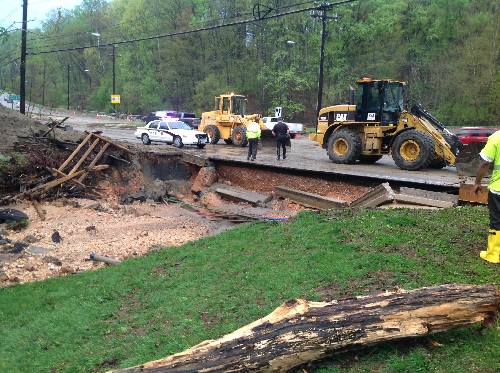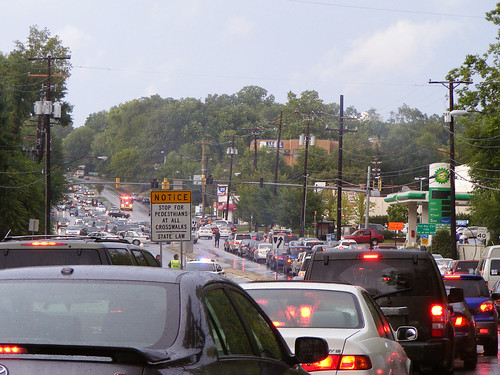Skeptics of Montgomery County's proposal to put bus lanes on major roads fear it could make traffic worse. But a road closure on Route 29 to repair recent storm damage might offer a glimpse of our possible future.
Two weeks ago, a torrential rainstorm flooded Route 29, also known as Columbia Pike, on a bridge where it crosses Northwest Branch in Silver Spring. This isn't the first time the bridge has flooded, and soon after, Maryland State Highway Administration closed the heavily damaged right lanes from Southwood Avenue to Lockwood Drive. Last Monday, it began making repairs, which will last until the end of May.
Montgomery County's Bus Rapid Transit plan envisions a line on Route 29 between Burtonsville and Silver Spring, which is already one of the region's busiest transit corridors, with 40 buses an hour during rush hour. Along most of the corridor, buses would have their own lanes, though we don't know if they would be on the curb or in the median, or if there would be a a reversible lane or lanes in both directions.
In any case, creating bus lanes would mean closing a lane to cars, which some residents in nearby Four Corners are vehemently opposed to. Thanks to last month's storm, we now get to see what closing a lane on Route 29 to general traffic might be like.
I've driven and taken the bus through the affected area a few times, including in evening rush hour. And there is some congestion, especially where drivers have to merge from three lanes to two. But the real test is what happens after people adjust to the new traffic pattern.
Studies have shown that taking away street space, often predicted to cause traffic mayhem, can actually reduce congestion as people find alternate ways to get there. Since the closure began, I've experimented with different routes. I've taken the bus at times of day when I would normally drive because there would be less traffic. Meanwhile, the sidewalks are still open, and I've noticed more people walking or biking to and from Trader Joe's across the bridge.
That may not seem like a big deal, but it only takes a 5% reduction in traffic to cause a 10 to 30% increase in traffic speed, meaning only a few people have to change their behavior in order for everyone to have a faster trip. It also explains why major highway closures around the country, like Carmageddon in Los Angeles, didn't cause the traffic they were anticipated to.
Of course, this isn't a perfect trial. The buses still have to share the remaining two lanes of traffic with everyone else. Unlike other, larger highway closures, there isn't a campaign directing drivers to other routes or beefed-up transit service. And unlike a road washout, a bus lane will give drivers another travel alternative to choose from instead of simply taking away street space.
But if Route 29 travelers can handle losing a lane for a few weeks, when the bridge is repaired, we might be able to do another trial with an actual bus lane.
 |
| The washed out bridge. Photo from SHA. |
Two weeks ago, a torrential rainstorm flooded Route 29, also known as Columbia Pike, on a bridge where it crosses Northwest Branch in Silver Spring. This isn't the first time the bridge has flooded, and soon after, Maryland State Highway Administration closed the heavily damaged right lanes from Southwood Avenue to Lockwood Drive. Last Monday, it began making repairs, which will last until the end of May.
Montgomery County's Bus Rapid Transit plan envisions a line on Route 29 between Burtonsville and Silver Spring, which is already one of the region's busiest transit corridors, with 40 buses an hour during rush hour. Along most of the corridor, buses would have their own lanes, though we don't know if they would be on the curb or in the median, or if there would be a a reversible lane or lanes in both directions.
In any case, creating bus lanes would mean closing a lane to cars, which some residents in nearby Four Corners are vehemently opposed to. Thanks to last month's storm, we now get to see what closing a lane on Route 29 to general traffic might be like.
I've driven and taken the bus through the affected area a few times, including in evening rush hour. And there is some congestion, especially where drivers have to merge from three lanes to two. But the real test is what happens after people adjust to the new traffic pattern.
 |
| Traffic on Route 29 after a flood in 2010. Photo by the author. |
Studies have shown that taking away street space, often predicted to cause traffic mayhem, can actually reduce congestion as people find alternate ways to get there. Since the closure began, I've experimented with different routes. I've taken the bus at times of day when I would normally drive because there would be less traffic. Meanwhile, the sidewalks are still open, and I've noticed more people walking or biking to and from Trader Joe's across the bridge.
That may not seem like a big deal, but it only takes a 5% reduction in traffic to cause a 10 to 30% increase in traffic speed, meaning only a few people have to change their behavior in order for everyone to have a faster trip. It also explains why major highway closures around the country, like Carmageddon in Los Angeles, didn't cause the traffic they were anticipated to.
Of course, this isn't a perfect trial. The buses still have to share the remaining two lanes of traffic with everyone else. Unlike other, larger highway closures, there isn't a campaign directing drivers to other routes or beefed-up transit service. And unlike a road washout, a bus lane will give drivers another travel alternative to choose from instead of simply taking away street space.
But if Route 29 travelers can handle losing a lane for a few weeks, when the bridge is repaired, we might be able to do another trial with an actual bus lane.

8 comments:
One of the alternatives that has (as best as I can tell) gotten no discussion is to do nothing at all along U.S. 29, but to divert express bus routes (Z11, Z29) that have traditionally run from Fairland and Laurel through Four Corners to instead use Md. 200 (ICC) and Md. 182 (Layhill Road) to the Red Line at the Glenmont station instead. It is about the same distance, but should be much faster and much more reliable.
How many times did your "alternate" route take you onto residential streets? This is a big concern of area neighborhoods and a legitimate one. Cut-through traffic disturbs the peace of neighborhoods and endangers children. The traffic is supposed to stay on arterial streets like 29, not be diverted off into neighborhoods.
C.P. I've thought this would be a good idea for a while, but it might require a bus fare adjustment to partially make up the cost of Metrorail from Glenmont to Silver Spring.
Woody, your belief is actually the fundamental problem of suburban driving. It provides for no alternatives when something like this flood happens, and is fundamentally undemocratic. As a taxpayer, I have as much right to drive on the public street outside your house as you do.
@Woody, Patrick
At least north of Four Corners, you can't take an alternate route through neighborhood streets because none of the streets connect. That's part of the reason why traffic on our main roads is so bad: every trip, whether someone's driving 20 miles or around the corner to get some milk, is forced to use the main roads. (And those short trips could be done on foot or bike instead of walking, but when the streets don't connect, the paths become longer and more circuitous, so people drive.)
I live on a through-street that has its fair share of speeding, and it sucks. But the answer isn't simply to close off that street, because it makes the main streets that much more congested and dangerous for everyone. (After all, there are families with kids on Wayne, Georgia, or Colesville who would love to let them play outside.)
I am not endorsing _any_ alternate route that deviates from roads on the state highway network - Md. 200 (ICC) and Md. 182 (Layhill Road) would see increased bus traffic under my suggestion, but both of them are state-maintained and not residential streets. As far as increased operating subsidies, I have heard many Red Line patrons complain quite bitterly about the "tripper" (or turn-back) trains on the Red Line that only run between Silver Spring and Grosvenor during peak commute times. If there is more demand for service (at least between Silver Spring and Glenmont), that ought to make people happy. Also, running between Fairland and Glenmont should mean that buses waste less time in congested traffic conditions, which does reduce operating costs.
Note that I am not absolutely certain that this is a good idea, but I do believe that it should at least be evaluated as part of an alternatives analysis.
Four Corners and 29 have been an absolute mess since this happened. Nothing's getting better with familiarity... nothing. Tell me about the left turn from EB Univ. Blvd onto 29... just tell me how great that's been. Tell me how I can get into my neighborhood via Crestmoor... which is now effectively sealed off due to bumper-to-bumper traffic 18+ hours a day.
The BRT concept is a total hoot (if by "hoot" you mean "incredible waste of time and money"). This county can't build a single to code (safe) building on-time and even close to budget. This county, until very recently, relied on a 30+ year old traffic light systems that required spare parts to be hunted down on eBay. So... now it's capable of building a (mostly experimental) BRT system... one of the biggest in the nation?!?
Please... spare me your pipe dreams until the MoCo powers that be can fix the terrible messes already on that are already on the table.
@Steve Six
While I get that people are frustrated with the Silver Spring Transit Center and that it's a colossal disaster, it's not really fair to say that Montgomery County can't build anything. The Silver Spring Library is nearing completion this year, and the new 3rd District Police Station just opened. And those are just the things in East County. Besides, a bus lane (which is basically what the county is proposing), is much less involved than a $120 million transit center. And if that's too experimental for Montgomery County...then I don't really know why anything's worth trying anymore.
Post a Comment